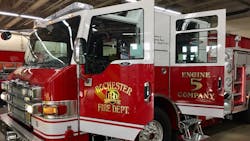MN Fire Department's Fleet Begins Going Green
By Emily Cutts
Source Post-Bulletin, Rochester, Minn.
Oct. 12—The Rochester Fire Department on Monday unveiled its new idle reduction technology intended to reduce carbon emissions and save on diesel fuel costs.
The department's two newest vehicles, the 100-foot aerial platform ladder Truck 42 and Engine 5, are the first vehicles to use this technology, which was designed in part by the fire department's emergency vehicle technician Jeremy Leisenheimer and Pierce Manufacturing.
"We are happy, preliminarily, with this step and the direction for a more sustainable future," Chief Eric Kerska said.
In its first year of use on Truck 42, Kerska said the idle time has been reduced by 60% and the department has saved about $3,000 in diesel fuel. It has also reduced the department's carbon emissions by about 6 tons.
RELATED
"We have big heavy trucks that use a lot of fuel, it just seemed the right thing to do," Kerska said of adding the more ecologically friendly system. "It's a focus of the community, it's a focus area of the city council, and so this we felt was a stepping stone, toward someday in the not too distant future, perhaps a fire truck that is a hybrid that drives on batteries."
When a truck is put in park and is idle for about five minutes, a computer shuts off the engine automatically. The engine's flashing lights as well as other systems like heating or cooling inside the cab are then powered by lithium-ion batteries until the system receives a signal that the batteries need to be recharged. For most calls, which take about 20 minutes, there isn't a need for the engine to turn back on, but for longer calls, or those during cold weather, the system monitors itself and restarts the engine if necessary.
The department hopes to be able to retrofit the existing fleet.
The new system added $20,000 to the cost of the engine. Savings in fuel, as well as maintenance, are expected to make up for the added cost over the life of the engines. The system also has has unintended benefits like noise reduction, which can make it easier for firefighters to communicate with one another while actively responding to a call.
___
(c)2021 the Post-Bulletin
Visit the Post-Bulletin at www.postbulletin.com
Distributed by Tribune Content Agency, LLC.






